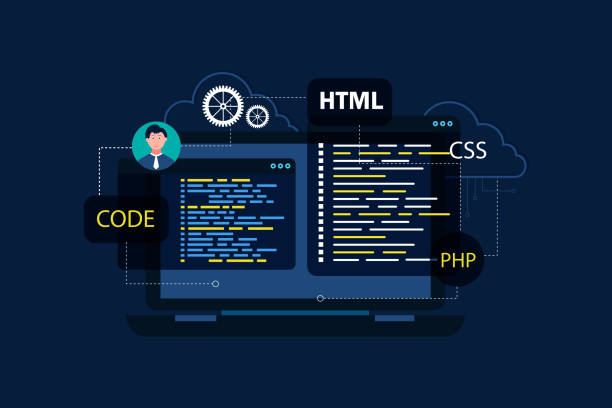Introduction to Secure Website Design and Its Importance

In the current digital age, where a vast amount of information is exchanged daily through websites, secure website design is no longer an option, but a vital necessity.
Websites are our primary gateways for communication, commerce, and information with the world, and as such, they are constantly exposed to various cyber threats.
Website security means protecting data, preventing unauthorized access, maintaining system integrity, and ensuring continuous access to services.
This includes protecting user personal information, sensitive business data, and a business’s online reputation.
Ignoring security aspects can lead to data theft, massive financial losses, loss of customer trust, and even complete brand reputation destruction.
The concept of #secure_website_design goes beyond merely installing an SSL certificate; it’s a comprehensive approach that encompasses everything from initial planning and coding stages to website deployment and continuous maintenance.
This approach requires adherence to high security standards at every layer of web architecture, from the server and database to front-end and back-end code.
A #secure_website is not only resistant to external attacks but also significantly helps in maintaining #user_privacy and #trust.
Given the increasing complexity of #cyber_attacks, awareness and implementation of secure website design principles are essential for every developer and website owner.
This article provides an explanatory and educational examination of various aspects of this topic.
Is your current corporate website not reflecting your brand’s credibility and power as it should? Rasaweb solves this challenge for you with professional corporate website design.
✅ Increase credibility and visitor trust
✅ Attract more targeted customers
⚡ Click for a free consultation!
Common Website Security Threats and Prevention Methods

Websites are constantly targeted by various cyber attackers, each with specific goals such as information theft, system destruction, or service disruption.
Understanding these threats is the first step in secure website design and implementing effective defense mechanisms.
One of the most common attacks is SQL Injection, where an attacker injects malicious SQL code into form inputs to gain access to the database and read, modify, or delete information.
To prevent this attack, using Prepared Statements and thorough input validation is essential.
Another attack is Cross-Site Scripting (XSS), which allows an attacker to inject malicious JavaScript code into web pages, steal user information, or perform unauthorized actions.
Output validation and HTML code filtering are ways to counter XSS.
DDoS (Distributed Denial of Service) attacks aim to disable websites by sending a massive volume of traffic.
Using CDNs and Web Application Firewalls (WAFs) can be effective in mitigating the effects of these attacks.
Phishing is also a social engineering technique that deceives users into entering their sensitive information on fake websites.
User awareness and the use of strong authentication protocols are of high importance.
Besides these, malware, Brute Force attacks, and software vulnerabilities are also common threats.
For secure website design, implementing a multi-layered defense strategy, including regular updates, strong encryption, proper access management, and continuous activity monitoring, is essential.
This section addresses these topics in a specialized and guiding manner.
SSL/TLS Security Protocols and Their Role in Data Protection

One of the most fundamental pillars in secure website design is the use of SSL/TLS encryption protocols.
These protocols are responsible for creating a secure communication channel between the user’s browser and the website server, ensuring that all data exchanged along the path is transmitted in an encrypted form.
This prevents eavesdropping, tampering, and forgery of information by attackers.
When a website uses SSL/TLS, its address starts with “HTTPS” and a lock icon is displayed in the browser’s address bar, indicating a secure connection.
SSL/TLS certificates are issued by Certificate Authorities (CAs) and verify the website’s identity.
There are different types of these certificates, each offering a different level of validation and trust.
The three main types of SSL certificates are: Domain Validation (DV), which only validates domain ownership and is suitable for blogs and personal sites; Organization Validation (OV), which validates the organization’s identity in addition to the domain and is recommended for small to medium businesses; and Extended Validation (EV), which offers the highest level of validation and includes a thorough legal and physical verification of the organization.
This type of certificate displays a green address bar in the browser and is ideal for financial and large commercial websites.
To implement secure website design, choosing the appropriate certificate and ensuring its correct configuration (such as using TLS 1.2 or higher and strong cipher suites) is crucial.
This section elaborates on these aspects in a specialized and explanatory manner.
A comparison table for certificate types is provided below:
| Certificate Type | Validation Level | Common Use Cases | Browser Display |
|---|---|---|---|
| Domain Validation (DV) | Low (Domain only) | Blogs, personal sites, non-commercial websites | Green lock |
| Organization Validation (OV) | Medium (Domain and Organization) | Corporate sites, small and medium businesses | Green lock + organization name in certificate details |
| Extended Validation (EV) | High (Domain, Organization, Legal) | Banks, large online stores, government organizations | Green lock + green address bar with organization name |
Database Security and Preventing SQL Injection Attacks

The database is the beating heart of every dynamic website, containing vital user, product, and transaction information.
Therefore, database security is a very important component in secure website design.
SQL Injection attacks are among the most dangerous and common threats against web databases.
These attacks occur when attackers manipulate user inputs (such as form fields or URL parameters) to inject malicious SQL code into database queries.
This can lead to unauthorized data access, modification or deletion of information, and even complete control over the database server.
To prevent SQL injection attacks in the secure website design process, several vital solutions exist:
The first and most important solution is to use Prepared Statements or Prepared Queries.
This method separates input data from the SQL query structure and prevents the input from being interpreted as part of the SQL code.
Most modern programming languages and frameworks support this feature.
Second, thorough Input Validation is crucial.
All user inputs must be validated and sanitized before being used in queries.
This includes checking data type, length, and allowed content.
Third, applying the Principle of Least Privilege.
This means that the database user account used by the website to connect to the database should only have the minimum necessary permissions to perform its tasks, e.g., only read access to specific tables it needs, not full database management access.
Fourth, using ORMs (Object-Relational Mappers) in modern web frameworks can automatically prevent many SQL injection attacks, as these tools use Prepared Statements by default.
Fifth, encrypting sensitive data in the database can prevent direct information disclosure, even in the event of a breach.
This comprehensive, guiding, and specialized approach ensures that your database is resilient against these types of attacks and contributes to elevating the level of secure website design.
Does your company’s website perform as well as your brand deserves? In today’s competitive world, your website is your most important online tool. Rasaweb, a specialist in professional corporate website design, helps you to:
✅ Gain customer credibility and trust
✅ Convert website visitors into customers
⚡ Get a free consultation!
Secure Coding and Prevention of XSS and CSRF Vulnerabilities

At the heart of every secure website design lies secure coding.
Even the best security protocols will be useless if there are vulnerabilities in the website’s programming code.
Two of the most common and dangerous vulnerabilities arising from insecure coding are Cross-Site Scripting (XSS) and Cross-Site Request Forgery (CSRF).
XSS occurs when an attacker successfully injects malicious JavaScript code into a web page.
These codes then execute in other users’ browsers and can lead to cookie theft, session hijacking, phishing, or alteration of page content.
XSS can be Reflected (injection via URL input), Stored (injection into the database and display on other pages), or DOM-based (DOM modification by client-side scripts).
To prevent XSS, thorough input and output validation is of high importance.
All user input data must be sanitized and filtered before storage or display.
Ensure proper escaping (converting special characters to HTML equivalents) when displaying user-generated content.
Using Content Security Policy (CSP) can also instruct browsers on where they can load scripts and other resources from, preventing the execution of malicious code.
CSRF, on the other hand, enables an attacker to perform unauthorized actions on behalf of an authenticated user, without their knowledge.
For example, an attacker can trick a user into clicking a malicious link that, in the background, sends a password change or fund transfer request to their banking website.
To counter CSRF in secure website design, using CSRF tokens (anti-CSRF tokens) is essential.
These tokens are random, unique values added to each form request, and the server verifies their match before processing the request.
Additionally, using the SameSite Cookie header can instruct the browser to send cookies only for same-site requests, preventing CSRF attacks.
This specialized and educational section helps developers become familiar with the principles of secure website design and write attack-resistant code.
Authentication and Access Control Management in Secure Website Design

Proper authentication and access control management are fundamental pillars of any secure website design.
These two concepts ensure that only authorized users access the system, and each user has access only to resources defined for their role.
Authentication is the process of verifying a user’s identity (usually via username and password), while access control determines what operations a user can perform and what resources they can access after authentication.
To strengthen authentication, enforcing strong password policies is vital; this includes requiring long, complex, and expiring passwords.
Passwords should be stored as hashes using algorithms resistant to brute-force attacks (such as Bcrypt or Argon2), not in plain text.
Multi-Factor Authentication (MFA), which requires a combination of at least two factors (something you know, something you have, something you are), adds a powerful security layer to user accounts and prevents unauthorized access even if the password is compromised.
Session Management is also important; session IDs should be randomly generated, have short expiration times, and be invalidated after user logout.
To prevent Session Hijacking, use Secure Cookies and the HttpOnly flag.
In terms of access control, the Role-Based Access Control (RBAC) model is widely recommended.
In RBAC, permissions are assigned to roles (e.g., administrator, editor, regular user), and users access resources based on their roles.
This approach simplifies access management and prevents the granting of excessive permissions.
Access validation must be performed server-side, not just client-side, as client-side code can be manipulated.
A secure website design involves thoroughly checking each request to ensure the user is authorized to perform that operation.
This section provides an explanatory and guiding overview of organizing and implementing these vital security aspects.
Firewalls, WAF, and CDN: Their Role in Enhancing Security

To enhance website security and achieve secure website design, in addition to internal measures in coding and databases, using external security tools like Firewalls, Web Application Firewalls (WAF), and Content Delivery Networks (CDN) is crucial.
Each of these tools provides an additional layer of defense and helps protect the website against various threats.
Firewalls act as a barrier between the internal network and the internet, filtering incoming and outgoing traffic based on a set of predefined rules.
They can block ports, restrict malicious IP addresses, and prevent unauthorized access to the server.
While network firewalls focus on lower layers of the OSI model, Web Application Firewalls (WAFs) go a step further.
WAFs are specifically designed to protect websites at the application layer (Layer 7 of the OSI model).
They can identify and block patterns of common web attacks such as SQL Injection, XSS, and Brute Force attacks.
WAFs can be implemented as a cloud service, server-side software, or a hardware appliance, and they actively protect the website by analyzing HTTP/HTTPS traffic.
Content Delivery Networks (CDNs), in addition to increasing website loading speed by caching content on servers closer to users, play a significant role in security.
Many CDNs offer built-in security features such as DDoS protection and malicious traffic filtering.
By distributing traffic and absorbing DDoS attacks, they can prevent malicious traffic from reaching the main website server.
These capabilities significantly contribute to the robustness of secure website design.
Proper selection and configuration of these tools are essential for a multi-layered defense approach.
This section provides a specialized and analytical examination of how these systems work and their security benefits.
A comparison table for WAF and traditional firewalls is provided below:
| Feature | Traditional Firewall (Network Firewall) | Web Application Firewall (WAF) |
|---|---|---|
| Operating Layer | Layer 3 and 4 (Network and Transport) | Layer 7 (Application) |
| Target Traffic | Any type of network incoming/outgoing traffic | Web application HTTP/HTTPS traffic |
| Protection Against | Port scanning, unauthorized network access | SQL Injection, XSS, CSRF, Layer 7 DDoS |
| Content Awareness | None (based on IP and port) | Yes (analyzes request content) |
| Deployment Location | Hardware, software, cloud (more general) | Hardware, software, cloud (web-specific) |
Regular Updates and Maintenance of a Secure Site

The process of secure website design does not end with initial launch; rather, it is a continuous and dynamic process that requires regular updates and maintenance.
Cyber threats are constantly evolving, and new vulnerabilities are continuously being discovered.
Therefore, neglecting updates can leave a website vulnerable to new attacks.
Regular updates of the server operating system, web server (such as Apache or Nginx), database (such as MySQL or PostgreSQL), programming language (such as PHP, Python, Node.js), and all frameworks, libraries, and plugins used on the website are of paramount importance.
The developers of this software continuously release security patches to fix discovered vulnerabilities.
Timely installation of these patches protects your website against exploitation of these vulnerabilities.
In addition to software updates, continuous monitoring of server logs to identify suspicious activities, regular website scanning to detect malware and vulnerabilities, and periodic penetration testing and vulnerability assessment are other critical aspects of maintaining a secure website.
Penetration testing simulates real attacks performed by security professionals to uncover potential weaknesses.
Furthermore, having a regular and reliable backup plan for all website data and files is essential so that in the event of a security incident or system failure, you can quickly restore the website.
This section, in a news-like and guiding manner, emphasizes the importance of a proactive and continuous approach to website security, as secure website design is not a one-time process, but a long-term commitment.
Is your current e-commerce website design causing you to lose customers and sales?
Rasaweb, with its modern and user-friendly e-commerce website designs, is your solution!
✅ Significantly increase conversion rates and sales
✅ Create strong branding and build customer trust
⚡ Get a free e-commerce website design consultation from Rasaweb!
Incident Response and Data Recovery Planning

Even with the best secure website design approaches and the implementation of the strongest defense mechanisms, security incidents can always occur.
No system is 100% impenetrable.
Therefore, having a comprehensive Incident Response Plan and a Disaster Recovery Plan is as crucial as the preventive measures themselves in secure website design.
These plans help organizations act quickly, efficiently, and organized in the face of a cyber attack, minimizing damages.
An incident response plan typically includes the following steps:
1.
Identification: Determining if a security incident has occurred and what its nature is.
This stage involves monitoring logs, Intrusion Detection/Prevention Systems (IDS/IPS), and user reports.
2.
Containment: Isolating affected systems to prevent the spread of the intrusion.
This might include disconnecting network access or isolating servers.
3.
Eradication: Eliminating the root cause of the incident, such as malware, software vulnerabilities, or compromised user accounts.
4.
Recovery: Restoring systems and services to normal operational status.
This may involve restoring from secure backups.
5.
Post-Incident Analysis: A thorough review of the incident to learn from it and strengthen future security measures.
What went wrong? How can it be prevented from happening again?
The data recovery plan also focuses on restoring business operations after a disaster (whether a cyberattack or natural disaster).
This includes having regular and tested backups of all data and configurations, storing backups in secure and separate locations, and periodically testing the recovery process to ensure its effectiveness.
Is your website capable of continuing operations even after a major breach? Can your customers still trust your services? These questions are vital at this stage.
Prior planning for these scenarios and having a responsible team can make the difference between a temporary halt and a complete disaster in the world of secure website design.
This section, in an analytical and thought-provoking manner, discusses the importance of preparing for worst-case scenarios.
The Future of Secure Website Design and Upcoming Challenges

The world of secure website design is constantly evolving, with threats becoming more complex and intelligent every day.
Therefore, anticipating future trends and preparing for upcoming challenges is of paramount importance for maintaining website security.
One of the most important future trends is the increased use of Artificial Intelligence (AI) and Machine Learning (ML) in both cyberattacks and cybersecurity.
Attackers will use AI to automate and smarten attacks, identify vulnerabilities, and even generate new malware.
Conversely, security professionals will leverage AI/ML to detect unknown attack patterns, analyze vast amounts of security data, and respond more quickly to threats.
Increased privacy regulations like GDPR in Europe and CCPA in California put more pressure on websites to manage and protect user data with greater care.
These regulations not only require secure website design but also demand “Privacy by Design” approaches where privacy is considered from the very beginning of system architecture.
The Internet of Things (IoT) and the proliferation of connected devices also pose new security challenges, as many of these devices have low security and can become entry points for larger attacks.
Furthermore, blockchain technology is being explored as a potential solution to enhance security and transparency in authentication, identity management, and data integrity, although it is still in its early stages.
Another challenge is the shortage of cybersecurity experts, which makes the need for training and educating a new generation of professionals in this field more essential than ever.
Given these changes, the future of secure website design requires an agile, proactive, and collaborative approach.
Websites must be continuously evaluated, updated, and leverage emerging technologies to strengthen their defenses.
This section explores these aspects in an engaging and analytical manner, outlining the future landscape of web security.
Frequently Asked Questions
| Question | Answer |
|---|---|
| 1. What does secure website design mean? | Secure website design means creating a website that is resilient against cyber attacks and protects user and server information. |
| 2. Why is security important in website design? | To prevent data breaches, maintain user privacy, retain user trust, and avoid financial and reputational losses. |
| 3. What are the most common web vulnerabilities? | SQL Injection, Cross-Site Scripting (XSS), Cross-Site Request Forgery (CSRF), Broken Authentication, and Security Misconfiguration. |
| 4. How can SQL Injection be prevented? | By using Prepared Statements / Parameterized Queries, ORMs, and Input Validation. |
| 5. What is the role of HTTPS and SSL/TLS in website security? | HTTPS uses the SSL/TLS protocol to encrypt communication between the user’s browser and the server, preventing eavesdropping and data tampering. |
| 6. What measures should be taken to prevent XSS attacks? | Input validation, output encoding to prevent execution of malicious code, and using Content Security Policy (CSP). |
| 7. What does a strong password policy include? | Requiring long passwords, a combination of uppercase and lowercase letters, numbers, and special characters, and preventing reuse. |
| 8. How does two-factor authentication (2FA) help with security? | Even if a user’s password is compromised, the attacker cannot access the account without access to the second authentication factor (such as an SMS code or an app). |
| 9. What is a Web Application Firewall (WAF) and what is its use? | A WAF is a firewall that monitors and filters HTTP traffic between a web application and the Internet to prevent common web attacks like SQL Injection and XSS. |
| 10. Why are regular updates of software and libraries important? | Updates often include security patches to fix discovered vulnerabilities. Failure to update can expose the site to new attacks. |
And other advertising services by Rasaweb Advertising Agency
Smart Sales Automation: Professional optimization for increased sales using attractive UI design.
Smart SEO: Transform online growth with Google Ads management.
Smart Brand Identity: An effective tool for user engagement through intelligent data analysis.
Smart Link Building: A dedicated service for growth in user engagement based on key page optimization.
Smart Marketplace: A dedicated service for increasing website traffic based on intelligent data analysis.
And over a hundred other services in the field of internet advertising, advertising consultation, and organizational solutions
Internet Advertising | Advertising Strategy | Advertorial
Sources
Secure Website Design Guide
Best Web Security Practices
Data Protection Strategies
Importance of SSL/TLS in Website Security
? Are you ready to revolutionize your business in the digital world? Rasaweb Digital Marketing Agency, with its expertise in custom website design, SEO, and digital marketing strategies, paves your path to success. Contact us today and build your digital future.
📍 Tehran, Mirdamad Street, Next to Central Bank, Kazeroon Southern Alley, Ramin Alley, No. 6



